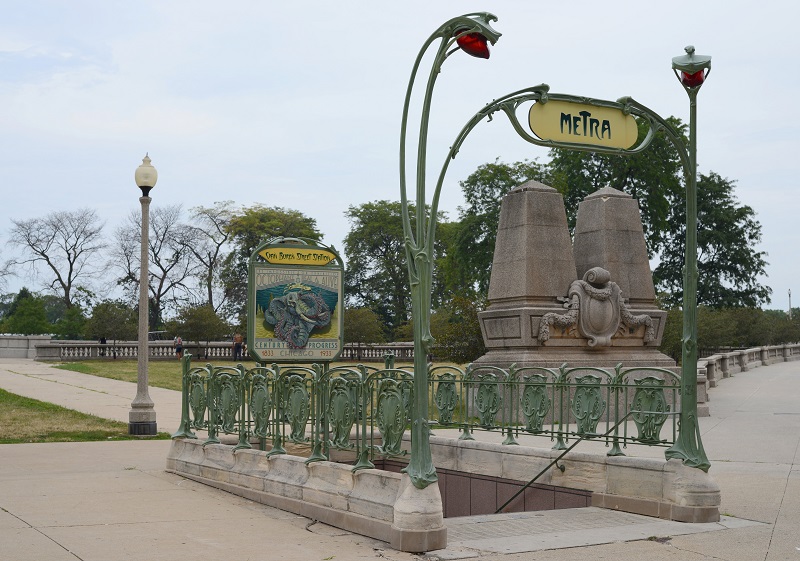Art Nouveau
Art Nouveau was a movement that emerged towards the end of the 19th century. It had a significant influence on the decorative arts and architecture but was relatively short-lived and fell out of favour in the 1920s with the arrival of Art Deco.
Art Nouveau was symptomatic of the struggle between the old and the new. Whilst it rejected some of the revivalist styles of the 19th century, it did adopt some of the elements of Rococo, with organic forms and applied art typified by Hector Guimard's Paris metro entrances.
The central aim of Art Nouveau was to escape the eclectic historical styles that had come to dominate the late-19th century and so modernise design. Inspiration was drawn from both organic and geometric forms, merging flowing, natural designs with more angular and rigid contours.
The movement adopted the ethos ‘form follows function’; however, as the style progressed designers began to incorporate more lavish decorations which led to criticisms that a tendency towards the elaborate was in conflict with its original ideology.
Art Nouveau had significant influence on graphic and visual arts and was a major source of inspiration for architecture in European cities such as Paris, Prague, Vienna, and Budapest. Prime examples include the Museum of Applied Arts in Budapest, and the Secession Building in Vienna, both of which demonstrate the style’s decorative and symmetric aesthetic. Also of note is the Grand Palais in Paris, which although predominantly Beaux Arts, drew from the Art Nouveau decorative style for the design of its interior glass dome.
Notable exponents of Art Nouveau in architecture include the American architect Louis Henry Sullivan, who used decorative plant-like ironmongery on traditionally structured buildings, and the Spanish architect Antonio Gaudi, who developed a highly-distinctive style to create curving, bulbous, and organic forms.
[edit] Related articles on Designing Buildings Wiki
- Aesthetic movement.
- Architectural styles.
- Art Deco.
- Art Moderne.
- Arts and craft movement
- Baroque architecture.
- Bauhaus.
- Beaux Arts style.
- Constructivist architecture.
- Deconstructivism.
- Edwardian architecture.
- High-tech architecture.
- Rococo.
[edit] External articles
- The Art Story - Art Nouveau
Featured articles and news
A change to adoptive architecture
Effects of global weather warming on architectural detailing, material choice and human interaction.
How big is the problem and what can we do to mitigate the effects?
Overheating guidance and tools for building designers
A number of cool guides to help with the heat.
The UK's Modern Industrial Strategy: A 10 year plan
Previous consultation criticism, current key elements and general support with some persisting reservations.
Building Safety Regulator reforms
New roles, new staff and a new fast track service pave the way for a single construction regulator.
Architectural Technologist CPDs and Communications
CIAT CPD… and how you can do it!
Cooling centres and cool spaces
Managing extreme heat in cities by directing the public to places for heat stress relief and water sources.
Winter gardens: A brief history and warm variations
Extending the season with glass in different forms and terms.
Restoring Great Yarmouth's Winter Gardens
Transforming one of the least sustainable constructions imaginable.
Construction Skills Mission Board launch sector drive
Newly formed government and industry collaboration set strategy for recruiting an additional 100,000 construction workers a year.
New Architects Code comes into effect in September 2025
ARB Architects Code of Conduct and Practice available with ongoing consultation regarding guidance.
Welsh Skills Body (Medr) launches ambitious plan
The new skills body brings together funding and regulation of tertiary education and research for the devolved nation.
Paul Gandy FCIOB announced as next CIOB President
Former Tilbury Douglas CEO takes helm.
UK Infrastructure: A 10 Year Strategy. In brief with reactions
With the National Infrastructure and Service Transformation Authority (NISTA).
Ebenezer Howard: inventor of the garden city. Book review.
Airtightness Topic Guide BSRIA TG 27/2025
Explaining the basics of airtightness, what it is, why it's important, when it's required and how it's carried out.























